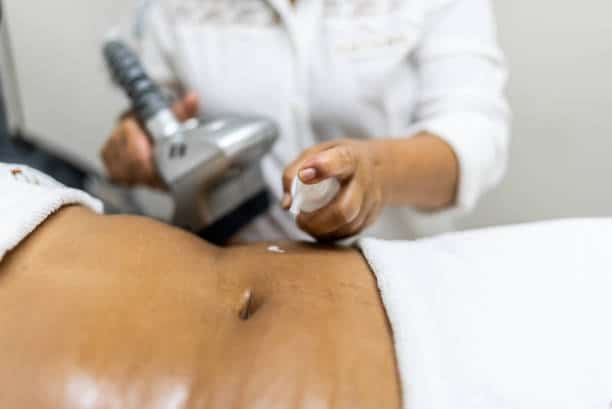Stretch Marks From Pregnancy? Try This…


Giving birth is giving life, and it’s one of the most transformative experiences a woman can have. Unfortunately, it can also be one of the most painful! And for many Black women, the consequences and changes following pregnancy also present their own range of pains and discomforts.
One of the most visible is the change to skin. Pregnancy has many effects on your skin; perhaps the most pronounced is stretch marks. If you’re unfamiliar with stretch marks, they’re exactly as they sound. When your skin stretches due to that baby bump, it more than leaves a mark.
In fact, stretch marks stem from changes in the deeper layers of the skin, and while generally harmless, they can be quite unsightly.
Fortunately, there are many ways to treat and reduce these pesky marks, whether with a simple cream or a more invasive procedure.
Let’s explore some of the top approaches for treating stretch marks post-pregnancy, as well as some lifestyle changes that can make it all work.
1. Topical Treatments
Sometimes, all your skin needs is a little TLC.
With popular moisturizing creams, oils, and lotions, many women find their stretch marks fading into obscurity. That’s because these products are precisely designed for nourishment and hydration, giving your skin the optimum nutrients it so desperately needs.
If you’re looking for top topicals, consider cocoa butter first. Cocoa butter is a known remedy, and given its rich fat content, is perfect for providing antioxidants and fatty acids your skin will soak up. It also prevents drying and cracking, which may exacerbate your stretch marks.
In fact, research shows cocoa butter can reduce the appearance of stretch marks, making it a perfect part of any healthy skincare routine.
In addition to this butter, consider another butter: shea butter. Filled with fatty acids and vitamins A and E, shea butter is a great anti-inflammatory compound for promoting skin regeneration. Your cells can undergo repairs, more collagen can arrive, and the overall strength and structure of your skin can improve.
Other oils and creams to consider are almond oil, argan oil, and rosehip oil. These are also rich in vitamins and fatty acids, and when used with retinol creams (full of vitamin A) can make a world of difference.
RELATED: 7 Ways To Avoid Stretch Marks During Pregnancy
2. Laser Treatments
If skincare with lotions, oils, and creams isn’t cutting it, consider laser treatments. More invasive, these laser treatments help reduce the look of stretch marks. There are generally two types of laser treatments: fractional CO2 lasers and pulsed dye lasers.
Fractional CO2 lasers are quite cool. They use controlled microbeams to injure your skin on a small scale. This, in turn, stimulates collagen production and can help improve your skin’s elasticity and strength. In other words, the skin is trained to heal itself! If you have more severe stretch marks, definitely consider CO2 laser treatment.
The second laser therapy is the pulsed dye laser.
Meant for red and purple stretch marks, a pulsed dye laser emits a light that is absorbed by vessels beneath your skin. From there, your blood vessels shrink, which can reduce the discoloration you so desperately want gone.
In both cases of laser, patients typically report minor side effects and complications. However, it may take several therapy sessions before the results are where you want them.
RELATED: 9 Ways To Naturally Remove Scars, Bruises & Stretch Marks
3. Chemical Peels
While the name may not sound great, the application of this treatment has shown promising results. For women with stretch marks, chemical peels work by removing the top layer of the skin through a chemical solution. This empowers the body to grow new skin, which may improve your texture and appearance with time.
The way chemical peels work is through exfoliation. In other words, they promote regeneration and reduce pigmentation anomalies, especially unsightly discoloration. In the end, your skin can look more even in tone and texture, which is a great way to disguise those marks.
Typically, a chemical peel procedure will use various acids, such as glycolic acid, salicylic acid, and lactic acid, all of which boost collagen production.
But a word of caution. Not all chemical peels are effective, and they’re usually recommended for people with less severe cases. If you have serious stretch marks, chemical peels may be used in addition to other therapies and treatments for optimum results.
4. Microneedling
As the name suggests, microneedling or collagen induction therapy is a procedure using tiny needles to cause tiny injuries all along the skin. By injuring the skin at a micro-scale, the body is then forced to heal, a process that allows more collagen and elastin. When collagen and elastin increase, the skin’s elasticity increases as well.
If you’re considering microneedling, consider the state of your skin. Older stretch marks (silver or white) usually respond the best. When used with other therapies, such as topical treatments, your skin can really improve.
Smoother, more even skin is especially possible when you accompany microneedling with retinol-based oils and creams. The procedure of microneedling is usually only slightly painful, if at all.
Just make sure you receive this treatment from a licensed practitioner to ensure the process is sterile and performed correctly.
RELATED: Rub These 5 Foods on Your Stretch Marks to Make them Disappear
5. Diet & Nutrition
Nutrition is one of those things we can all do, without pricey treatments or fancy skincare products. As you can imagine, a diet rich in the right vitamins and minerals can go a long way in improving the health of your flesh. Good nutrition is especially important if you’re still early in pregnancy, as it’s a great way to prevent stretch marks in the first place.
If you’re wondering which nutrients are best, first look into vitamins C & E. When taking vitamin C, you improve your skin’s structure and strength. Consider leafy greens, citrusy foods, and bell peppers. For vitamin E, foods like seeds, nuts, and leafy veggies are great sources.
Omega-3 fats are also important. They stem from fatty fish, walnuts, and flaxseeds, and work by preserving your skin’s natural barrier. By strengthening this lipid barrier, omega-3s help keep your skin moist and elastic.
Then you’ve got zinc and collagen supplements. Zinc is great for both healing injuries and producing collagen, and is found in shellfish, legumes, and pumpkin seeds. Meanwhile, collagen supplements work by increasing skin elasticity. As a vital protein, collagen is critical for treating the appearance of stretch marks.
Overall, diet, treatments, therapies, and supplementation all play a crucial role in healing your stretch marks. Whether you’re currently pregnant and wanting to prevent stretch marks, or have lingering stretch marks from years before, you can still benefit.
Speak to your healthcare provider, seek a personalized treatment that works, and make the most of your skincare routine today. With consistency and a little effort, you may be surprised just how effective these approaches are!




